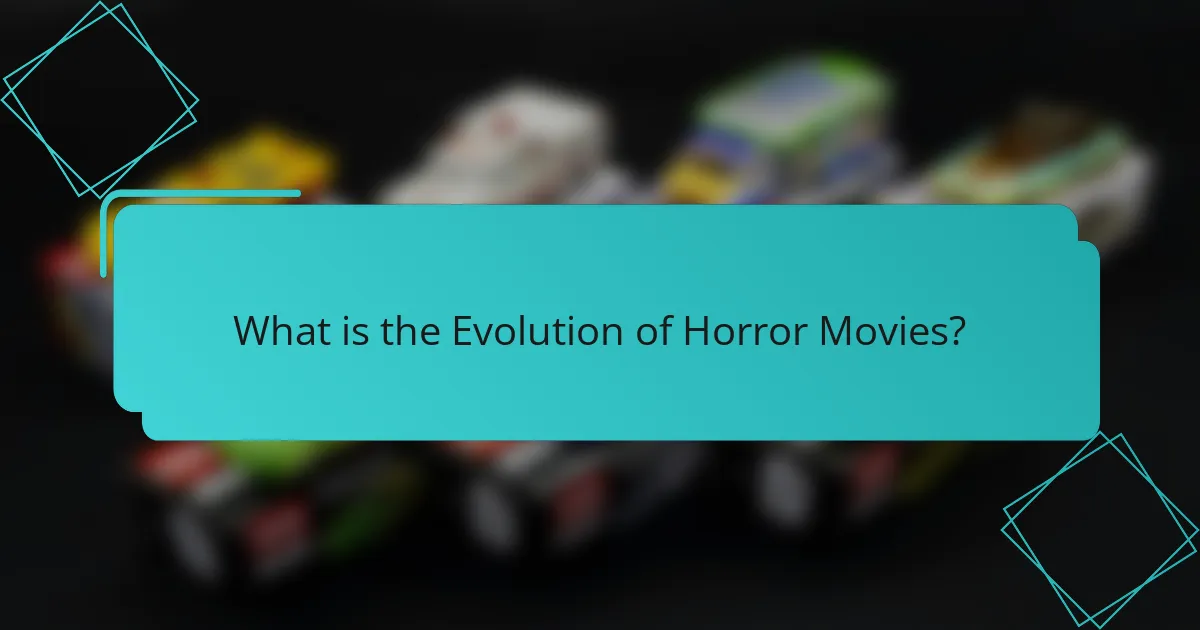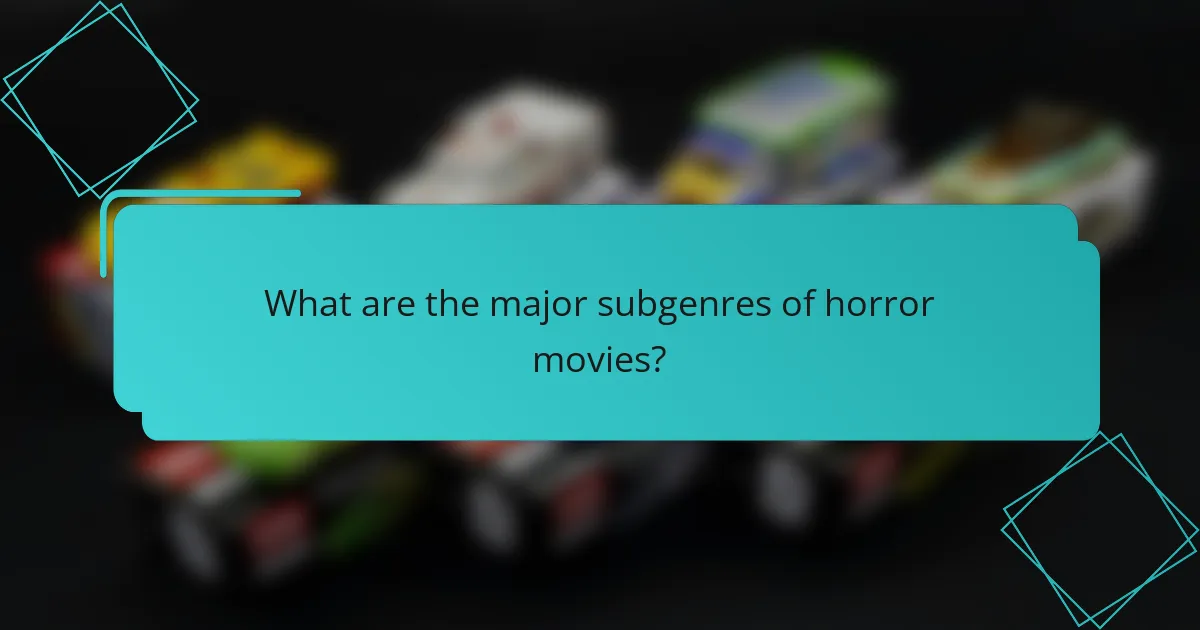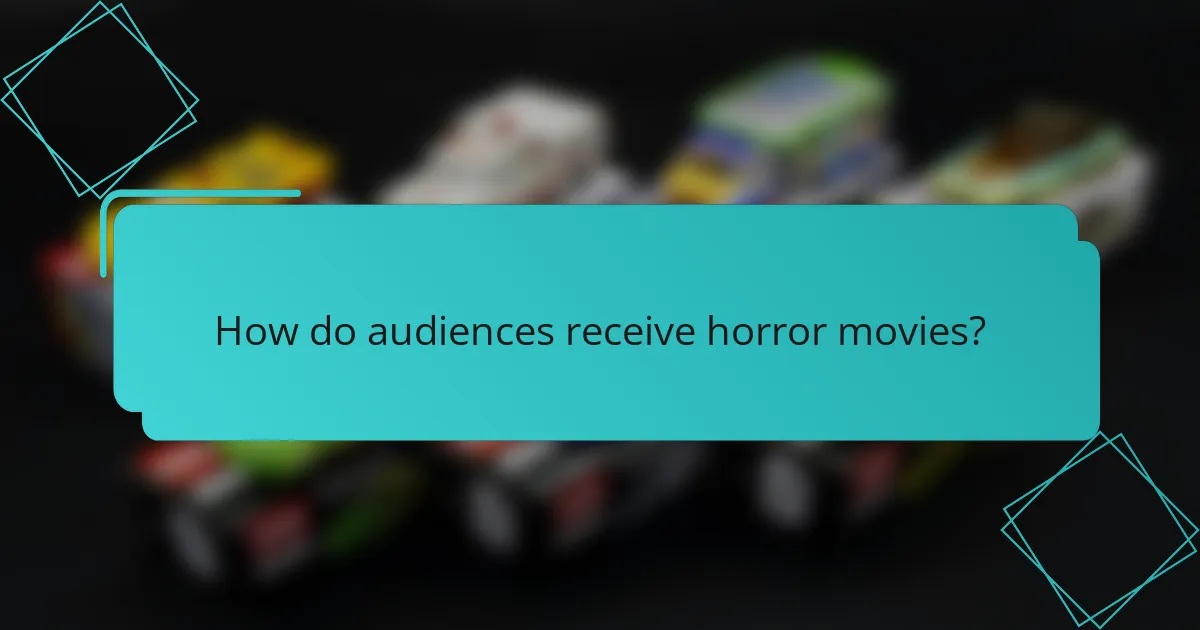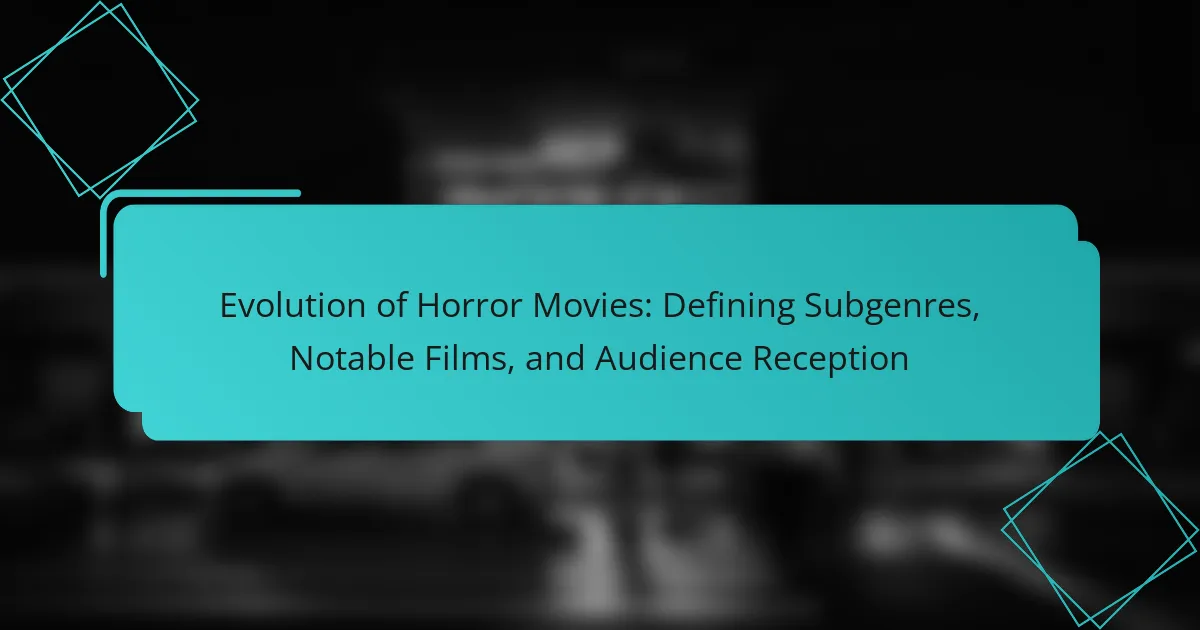The article examines the evolution of horror movies, tracing their development from early silent films to contemporary blockbusters. Key milestones include the introduction of expressionism in the 1920s, the emergence of Universal Monsters in the 1930s, and the rise of psychological horror in the 1960s and 1970s. It also highlights major subgenres such as psychological horror, supernatural horror, slasher films, and body horror, each eliciting fear through distinct mechanisms. Notable films like “Psycho,” “The Exorcist,” and “Get Out” are discussed for their significant impact on the genre. The article concludes by exploring audience reception, emphasizing the emotional responses and social interactions that enhance the horror viewing experience.

What is the Evolution of Horror Movies?
The evolution of horror movies spans from early silent films to modern blockbusters. The genre began in the late 19th century with films like “Le Manoir du Diable” in 1896. The 1920s introduced expressionism, exemplified by “The Cabinet of Dr. Caligari.” The 1930s solidified the genre with Universal Monsters like Dracula and Frankenstein. The 1960s and 1970s saw psychological horror rise with films like “Psycho” and “The Exorcist.” The 1980s introduced slasher films, highlighted by “Halloween” and “A Nightmare on Elm Street.” The 2000s brought found footage with “The Blair Witch Project.” Today, horror films explore diverse themes and subgenres, reflecting societal fears and anxieties. The evolution showcases changing audience tastes and filmmaking techniques.
How have horror movies changed over the decades?
Horror movies have evolved significantly over the decades. In the 1920s and 1930s, classic monsters like Dracula and Frankenstein defined the genre. The 1950s introduced science fiction elements, reflecting societal fears of the atomic age. The 1970s saw the rise of psychological horror, exemplified by films like “The Exorcist.” The 1980s popularized slasher films, with iconic characters such as Michael Myers and Freddy Krueger. The 1990s and early 2000s brought self-referential horror, as seen in “Scream.” Recent years have focused on social commentary, with films like “Get Out” addressing racial issues. Each decade reflects cultural anxieties and shifts in audience expectations.
What historical events influenced the evolution of horror films?
The evolution of horror films has been influenced by several historical events. The Industrial Revolution led to urbanization and societal changes, creating a backdrop for horror themes. World War I and II introduced themes of trauma and existential dread, shaping narratives in horror cinema. The Great Depression influenced the portrayal of fear and survival in films. The Cold War era brought paranoia and nuclear fears, evident in movies like “Invasion of the Body Snatchers.” Civil rights movements and counterculture of the 1960s challenged societal norms, reflected in horror’s exploration of taboo subjects. Technological advancements in special effects expanded the genre’s possibilities, evident in films like “Psycho” and “The Exorcist.” Each of these events contributed to the thematic depth and stylistic evolution of horror films.
How have technological advancements impacted horror movie production?
Technological advancements have significantly transformed horror movie production. Improved special effects technology allows for more realistic and terrifying visuals. Digital cinematography enhances lighting and color grading, creating a more immersive atmosphere. Sound design has evolved with advanced audio technology, heightening suspense through innovative soundscapes. The use of CGI enables the creation of creatures and environments that were previously impossible. Streaming platforms have changed distribution methods, allowing for wider audience reach. Virtual reality and augmented reality are emerging as new storytelling mediums in horror. These advancements have collectively elevated the horror genre, making it more engaging and accessible to audiences.
What are the defining characteristics of horror movies?
Horror movies are defined by their ability to evoke fear and suspense. They often feature supernatural elements, psychological terror, or graphic violence. Common characteristics include a dark atmosphere, unsettling sound design, and themes of mortality. Characters frequently face life-threatening situations, often leading to a fight for survival. The genre often employs jump scares and tension-building techniques to engage viewers. Iconic horror films, such as “Psycho” and “The Exorcist,” exemplify these traits. Historical data indicates that horror films have consistently attracted audiences, reflecting societal fears and anxieties. The genre’s evolution showcases diverse subgenres, including slasher, psychological, and supernatural horror.
What themes are commonly explored in horror films?
Common themes explored in horror films include fear of the unknown, isolation, and the supernatural. Fear of the unknown often drives the plot, creating tension and suspense. Isolation amplifies characters’ vulnerabilities, making them more susceptible to threats. The supernatural theme introduces elements beyond the natural world, such as ghosts or monsters. Other prevalent themes are psychological terror, where characters face their own minds, and societal fears reflecting cultural anxieties. These themes are evident in classic films like “Psycho” and modern hits like “Get Out.” Each theme serves to evoke strong emotional responses from the audience, reinforcing horror’s impact.
How do horror movies evoke fear and suspense?
Horror movies evoke fear and suspense through various techniques. These techniques include sound design, visual imagery, and narrative structure. Sound design creates tension with unsettling music and sudden noises. Visual imagery often features dark settings and grotesque characters. Narrative structure builds suspense by delaying the reveal of threats. The use of jump scares can provoke immediate reactions. Psychological elements, such as exploring fears and anxieties, deepen emotional engagement. Research indicates that horror films activate the brain’s fear response, increasing adrenaline and heart rate. Studies show that audiences often enjoy the thrill of fear in a safe environment.

What are the major subgenres of horror movies?
The major subgenres of horror movies include psychological horror, supernatural horror, slasher films, and body horror. Psychological horror focuses on the mental state of characters, creating tension through fear and paranoia. Supernatural horror involves elements like ghosts, demons, and otherworldly beings. Slasher films typically feature a killer stalking and murdering a group of people, often with graphic violence. Body horror emphasizes the grotesque and disturbing transformation of the human body. Each subgenre elicits fear through different mechanisms, appealing to various audience preferences.
How do different horror subgenres differentiate themselves?
Different horror subgenres differentiate themselves through unique themes, narrative styles, and emotional responses. For example, psychological horror focuses on the mental states of characters. It evokes fear through suspense and tension rather than visual scares. In contrast, supernatural horror includes elements like ghosts or monsters. This subgenre relies on the unknown and otherworldly to instill fear.
Slasher films emphasize graphic violence and a killer’s perspective. They often follow a formulaic structure involving a final girl trope. Meanwhile, body horror explores the grotesque transformation of the human body. This subgenre creates discomfort by depicting physical mutilation or disease.
Found footage horror utilizes a documentary-style approach. It presents events as if captured by the characters themselves, enhancing realism. Each subgenre caters to different audience fears and preferences. The distinctions in themes and storytelling techniques contribute to the overall diversity in horror cinema.
What are the key features of psychological horror films?
Psychological horror films primarily focus on the mental and emotional states of characters. They often explore themes of fear, paranoia, and anxiety. These films create tension through atmosphere rather than explicit violence. They frequently feature unreliable narrators, leading to ambiguity in the storyline. Character development is crucial, as viewers are drawn into the characters’ psychological struggles. The use of sound and visual techniques enhances the unsettling experience. Common settings include isolated environments that amplify feelings of dread. These elements combine to evoke a sense of unease that lingers long after viewing.
What defines slasher films and their impact on the genre?
Slasher films are defined by their focus on a psychopathic killer who stalks and murders a group of people, typically teenagers. This subgenre often features graphic violence, suspenseful music, and a final girl trope. The impact of slasher films on the horror genre is significant. They popularized a formula that combines horror and thriller elements. Iconic films like “Halloween” (1978) established conventions such as the masked killer and the use of POV shots. The success of slasher films influenced countless other horror movies, leading to a resurgence of interest in the genre during the 1980s. They also sparked discussions around morality and the portrayal of violence in media.
Which subgenres have emerged in recent years?
Recent years have seen the emergence of several new horror subgenres. Notably, the “elevated horror” subgenre has gained popularity. This subgenre emphasizes psychological depth and social commentary. Films like “Hereditary” and “Get Out” exemplify this trend. Another emerging subgenre is “folk horror,” which draws from rural and cultural folklore. Titles such as “Midsommar” showcase this unique approach. Additionally, “tech horror” has surfaced, focusing on the fears associated with technology. Movies like “[censured]” and “Unfriended” illustrate this modern concern. These subgenres reflect evolving audience interests and societal anxieties.
How has the rise of found footage films shaped audience expectations?
The rise of found footage films has significantly shaped audience expectations regarding realism and immersion. Viewers now anticipate a raw, unpolished aesthetic that mimics real-life experiences. This genre’s popularity has led audiences to expect a higher degree of emotional engagement and authenticity. Films like “The Blair Witch Project” and “Paranormal Activity” set benchmarks for this style. These movies often employ shaky camera work and naturalistic dialogue, enhancing the illusion of reality. As a result, audiences have become more critical of traditional cinematic techniques. They now seek narratives that feel personal and immediate. This shift has influenced not only horror but also other genres, pushing filmmakers to adopt similar techniques to meet audience demands.
What role do supernatural elements play in modern horror?
Supernatural elements serve as a crucial component in modern horror. They create an atmosphere of fear and uncertainty. These elements often include ghosts, demons, and otherworldly beings. They challenge the boundaries of reality. This creates tension and suspense in the narrative. Supernatural occurrences often symbolize deeper psychological fears. For instance, they can represent trauma or societal anxieties. Films like “The Conjuring” and “Hereditary” exemplify this use. They effectively engage audiences by tapping into primal fears of the unknown.

What are some notable films in the horror genre?
Notable films in the horror genre include “Psycho,” “The Exorcist,” and “Get Out.” “Psycho,” directed by Alfred Hitchcock, is a classic that revolutionized psychological horror. It was released in 1960 and is known for its iconic shower scene. “The Exorcist,” released in 1973, is famous for its depiction of demonic possession and has been critically acclaimed. “Get Out,” directed by Jordan Peele in 2017, addresses social themes through horror elements. Each of these films has received significant recognition and has influenced the genre.
Which classic horror films have left a lasting legacy?
Classic horror films that have left a lasting legacy include “Psycho,” “Night of the Living Dead,” and “The Exorcist.” “Psycho,” directed by Alfred Hitchcock in 1960, revolutionized the horror genre with its narrative structure and shocking plot twists. “Night of the Living Dead,” released in 1968, introduced the modern zombie archetype and social commentary on race and society. “The Exorcist,” released in 1973, became a cultural phenomenon, known for its intense portrayal of demonic possession and groundbreaking special effects. Each of these films has influenced countless filmmakers and shaped the horror genre’s evolution. Their impact is evident in both cinema and popular culture.
What innovations did films like “Psycho” and “The Exorcist” introduce?
“Psycho” and “The Exorcist” introduced significant innovations in the horror genre. “Psycho” utilized shocking plot twists and a focus on psychological horror. It broke conventions by killing the main character early in the film. This unexpected turn heightened suspense and altered audience expectations. Alfred Hitchcock’s use of music and editing created a sense of dread that was unprecedented.
“The Exorcist” introduced religious themes and a focus on supernatural horror. It depicted the struggle between good and evil through the lens of demonic possession. The film employed groundbreaking special effects to portray the exorcism, enhancing its realism. Its marketing strategy also set new standards by promoting it as a terrifying experience.
Both films pushed boundaries in storytelling and visual techniques, influencing countless horror films that followed.
How did “Halloween” redefine the slasher genre?
“Halloween” redefined the slasher genre by establishing key conventions that influenced future films. It introduced the concept of a relentless, masked killer, Michael Myers, who embodies pure evil. The film’s use of suspense and tension was groundbreaking, focusing on atmosphere rather than gore. It popularized the “final girl” trope, where a female character survives to confront the killer. “Halloween” also emphasized the importance of music, with John Carpenter’s iconic score heightening dread. The film’s success at the box office, grossing over $70 million on a budget of $300,000, demonstrated the commercial viability of the slasher genre. Its influence can be seen in numerous subsequent films, solidifying its status as a seminal work in horror cinema.
What are some contemporary horror films that have gained critical acclaim?
Some contemporary horror films that have gained critical acclaim include “Get Out,” “Hereditary,” and “The Babadook.” “Get Out,” directed by Jordan Peele, received widespread praise for its social commentary and unique storytelling. It holds a 98% approval rating on Rotten Tomatoes. “Hereditary,” directed by Ari Aster, is noted for its intense atmosphere and strong performances, especially by Toni Collette. It has an 89% approval rating on Rotten Tomatoes. “The Babadook,” directed by Jennifer Kent, is acclaimed for its psychological depth and exploration of grief. It has a 98% approval rating on Rotten Tomatoes. These films have not only resonated with audiences but have also been recognized in various award circuits, further solidifying their status in contemporary horror cinema.
How do films like “Get Out” and “Hereditary” reflect current societal issues?
Films like “Get Out” and “Hereditary” reflect current societal issues through their exploration of race, mental health, and family dynamics. “Get Out” addresses systemic racism and cultural appropriation by depicting a black man’s harrowing experience in a predominantly white environment. This film sparked conversations about racial tensions and identity in contemporary society.
Similarly, “Hereditary” delves into themes of trauma and mental illness within a family context. It highlights how unresolved grief and generational trauma can manifest in destructive ways. This portrayal resonates with audiences facing similar societal pressures around mental health.
Both films utilize horror to critique societal norms. They engage viewers in discussions about the psychological and social implications of their narratives. This approach reflects a growing trend in horror cinema to address real-world issues while entertaining audiences.
What makes “A Quiet Place” a unique entry in the horror genre?
“A Quiet Place” is unique in the horror genre due to its innovative use of sound and silence. The film relies on minimal dialogue, creating tension through auditory elements. This approach heightens the viewer’s sensory experience. The premise revolves around creatures that hunt by sound, emphasizing the importance of silence. The family dynamic adds emotional depth, differentiating it from typical horror narratives. Director John Krasinski’s vision blends suspense with heartfelt storytelling. The film received critical acclaim, evidenced by a 95% approval rating on Rotten Tomatoes. Its box office success, grossing over $340 million worldwide, further underscores its impact.

How do audiences receive horror movies?
Audiences receive horror movies through a combination of emotional responses and psychological engagement. They often experience fear, suspense, and excitement while watching. Research shows that horror films can trigger the release of adrenaline. This physiological response heightens their senses and creates a thrilling experience. According to a study published in the Journal of Media Psychology, horror films can evoke strong emotional reactions. Audiences may also engage with horror movies through social contexts, sharing reactions with friends or discussing themes online. This collective experience can enhance their enjoyment and interpretation of the film.
What factors influence audience reactions to horror films?
Audience reactions to horror films are influenced by several key factors. These factors include individual psychological traits, cultural background, and the film’s narrative structure. Psychological traits such as fear sensitivity and personal experiences shape how viewers perceive horror elements. Cultural background affects the interpretation of themes and symbols presented in the film. Additionally, the narrative structure, including pacing and suspense, can heighten emotional responses. Research indicates that viewers with higher anxiety levels tend to react more intensely to horror scenes. Studies have shown that cultural context can lead to varying interpretations of fear. For instance, a film that relies on folklore may resonate differently across cultures. These factors collectively determine the overall impact of horror films on audiences.
How do cultural backgrounds shape perceptions of horror?
Cultural backgrounds significantly shape perceptions of horror. Different cultures have unique beliefs, traditions, and fears that influence what they find frightening. For example, Western horror often emphasizes psychological terror and the supernatural. In contrast, Eastern horror may focus on folklore and ancestral spirits.
Research shows that cultural narratives affect horror film reception. A study by K. S. Lee in “The Journal of Popular Film and Television” found that cultural context alters audience interpretation of horror elements. This indicates that horror is not universally perceived but is instead filtered through cultural lenses.
Additionally, horror tropes can resonate differently across cultures. For instance, the fear of the unknown may be more pronounced in cultures with strong communal ties. This cultural specificity results in varying horror subgenres that reflect local fears and societal issues.
What psychological effects do horror films have on viewers?
Horror films induce a range of psychological effects on viewers. Common reactions include heightened anxiety and increased heart rate. These films often trigger the fight-or-flight response. This response results in adrenaline release, leading to a temporary state of heightened awareness. Viewers may also experience desensitization to violence over time. Research indicates that frequent exposure can alter emotional responses to real-life threats. Additionally, horror films can foster a sense of relief and catharsis after viewing. This is due to the contrast between fear and the return to safety. Studies show that horror films can enhance mood and provide a shared social experience among viewers.
How has audience reception changed with the advent of streaming services?
Audience reception has significantly changed with the advent of streaming services. Streaming platforms have provided greater accessibility to a diverse range of horror films. Viewers can now easily discover niche subgenres that were previously difficult to find. This accessibility has led to increased engagement with horror content. Audiences have developed a preference for binge-watching series and films. Streaming services often release entire seasons at once, altering viewing habits. Additionally, user-generated ratings and reviews on these platforms influence audience perceptions. According to a 2021 report by Nielsen, streaming accounted for over 28% of total TV viewing time in the U.S. This shift has empowered viewers to curate their own horror experiences, impacting traditional box office revenue.
What role do social media and online communities play in horror film discussions?
Social media and online communities significantly enhance discussions around horror films. They provide platforms for fans to share opinions and interpretations. These discussions often lead to deeper analysis of themes and subgenres. Social media allows for real-time engagement during film releases. Online communities foster a sense of belonging among horror enthusiasts. They also facilitate the sharing of fan theories and creative content. Research shows that platforms like Reddit and Twitter amplify audience engagement. This interaction influences film marketing and audience expectations.
How do streaming platforms influence the production of horror content?
Streaming platforms significantly influence the production of horror content by prioritizing diverse storytelling and niche subgenres. They provide creators with the freedom to explore unconventional themes and styles. This leads to a wider variety of horror films being produced, catering to specific audience preferences. For example, platforms like Netflix and Hulu have funded original horror projects that may not succeed in traditional theaters. Their data-driven approach allows them to identify emerging trends and audience interests. This results in tailored content that resonates with specific demographics. Additionally, streaming platforms enable global distribution, allowing international horror films to reach wider audiences. The success of films like “The Haunting of Hill House” demonstrates this impact, as it garnered critical acclaim and viewership. Overall, streaming platforms reshape the horror landscape by fostering innovation and accessibility in content production.
What are some tips for enjoying horror movies?
To enjoy horror movies, create a comfortable viewing environment. Dim the lights to enhance the atmosphere. Choose a genre that appeals to you, such as psychological or supernatural horror. Watching with friends can increase enjoyment through shared reactions. Pay attention to the film’s sound design; it often heightens suspense. Engage with the plot by predicting outcomes and analyzing characters. Allow yourself to feel fear; it’s part of the experience. Lastly, take breaks if needed to manage intense emotions.
How can viewers prepare for a horror movie marathon?
Viewers can prepare for a horror movie marathon by creating a comfortable viewing environment. This includes dimming the lights to enhance the spooky atmosphere. Snacks and drinks should be readily available to avoid interruptions. Selecting a lineup of films in advance helps maintain a smooth viewing experience. It’s beneficial to choose a mix of subgenres to keep the marathon engaging. Inviting friends can enhance the experience through shared reactions. Setting a schedule for breaks ensures viewers can recharge without missing key moments. Research shows that social viewing can increase enjoyment and engagement with horror films.
What strategies can enhance the viewing experience of horror films?
To enhance the viewing experience of horror films, viewers can implement several strategies. Watching in a dark environment increases immersion and heightens tension. Using high-quality sound systems amplifies jump scares and atmospheric sounds. Engaging in group viewings can create a shared emotional response. Taking breaks during intense scenes can help manage anxiety. Familiarizing oneself with horror tropes can deepen appreciation for the genre. Viewing films with a critical lens allows for analysis of themes and techniques. Lastly, exploring behind-the-scenes content can provide insight into filmmaking choices. These strategies collectively improve the overall enjoyment and understanding of horror films.
The main entity of this article is the evolution of horror movies, encompassing their historical development, defining subgenres, notable films, and audience reception. The article outlines the progression of horror films from early silent works to contemporary blockbusters, highlighting key historical influences and technological advancements that have shaped the genre. It details various subgenres, such as psychological horror, slasher films, and supernatural horror, while also discussing the impact of notable films like “Psycho,” “The Exorcist,” and “Get Out.” Additionally, the article examines how audience perceptions and reactions to horror films have changed, particularly with the rise of streaming platforms and social media engagement.
